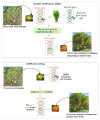Does Preferred Information Format Affect Consumers' Willingness to Pay: A Case Study of Orange Juice Produced by Biotechnology
- PMID: 37297375
- PMCID: PMC10252264
- DOI: 10.3390/foods12112130
Does Preferred Information Format Affect Consumers' Willingness to Pay: A Case Study of Orange Juice Produced by Biotechnology
Abstract
People who received a more personally relevant message were motivated to pay closer attention to the information and actively process it, which ultimately may stimulate behavioral changes. Therefore, preferred information content has been used in many disciplines to promote effective communication. However, no study has explored the impact of preferred information formats (e.g., word, infographic, and video) concerning food production. With the increasing application of biotechnology to food production, a complex topic to communicate, and evidence that consumers were willing to pay less for bioengineered foods, efficient communication was important to impact consumer preferences. The results of this study showed that consumers mostly preferred information format is writing. Providing information in video format did improve consumers' trust in information about food biotechnology. However, receiving information in consumers' preferred formats did not significantly change consumers' WTP for genetically engineered orange juice.
Keywords: genetically modified organisms; preferred information format; willingness to pay.
Conflict of interest statement
The authors declare no conflict of interest.
Figures
Similar articles
-
Consumer willingness to pay for plant-based foods produced using microbial applications to replace synthetic chemical inputs.PLoS One. 2021 Dec 7;16(12):e0260488. doi: 10.1371/journal.pone.0260488. eCollection 2021. PLoS One. 2021. PMID: 34874958 Free PMC article.
-
Consumers' willingness to pay for nutritional claims fighting the obesity epidemic: the case of reduced-fat and low salt cheese in Spain.Public Health. 2016 Jun;135:83-90. doi: 10.1016/j.puhe.2016.02.004. Epub 2016 Mar 17. Public Health. 2016. PMID: 26996310
-
Effects of information on young consumers' willingness to pay for genetically modified food: experimental auction analysis.Ecol Food Nutr. 2014;53(3):292-311. doi: 10.1080/03670244.2013.824433. Ecol Food Nutr. 2014. PMID: 24735210
-
Surveys suck: Consumer preferences when purchasing genetically engineered foods.GM Crops Food. 2013 Jul-Dec;4(3):195-201. doi: 10.4161/gmcr.26777. Epub 2013 Nov 12. GM Crops Food. 2013. PMID: 24281042 Review.
-
The credibility of the effects of functional food products and consumers' willingness to purchase/willingness to pay- review.Appetite. 2019 Dec 1;143:104398. doi: 10.1016/j.appet.2019.104398. Epub 2019 Aug 8. Appetite. 2019. PMID: 31401236 Review.
Cited by
-
How Sugar Labeling Affects Consumer Sugar Reduction: A Case of Sucrose Grade Labels in China.Foods. 2024 Jun 8;13(12):1803. doi: 10.3390/foods13121803. Foods. 2024. PMID: 38928745 Free PMC article.
References
-
- Hu Y., House L.A., Gao Z. How do consumers respond to labels for crispr (gene-editing)? Food Policy. 2022;112:102366. doi: 10.1016/j.foodpol.2022.102366. - DOI
-
- Massa L.J., Mayer R.E. Testing the ATI hypothesis: Should multimedia instruction accommodate verbalizer-visualizer cognitive style? Learn. Individ. Differ. 2006;16:321–335. doi: 10.1016/j.lindif.2006.10.001. - DOI
-
- Gerjets P., Scheiter K. Goal Configurations and Processing Strategies as Moderators between Instructional Design and Cognitive Load: Evidence From Hypertext-Based Instruction. Educ. Psychol. 2003;38:33–41. doi: 10.1207/S15326985EP3801_5. - DOI
Grants and funding
LinkOut - more resources
Full Text Sources





